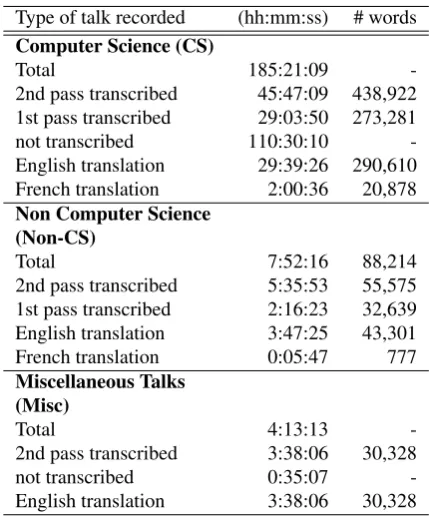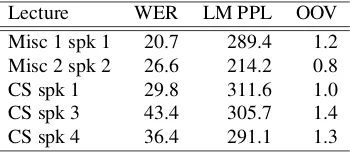The KIT Lecture Corpus for Speech Translation
Sebastian St ¨uker
1,2, Florian Kraft
1, Christian Mohr
1, Teresa Herrmann
1, Eunah Cho
1and Alex Waibel
11Interactive Systems Laboratories
2Research Group 3-01 ‘Multilingual Speech Recognition’
Karlsruhe Institute of Technology Karlsruhe, Germany
{sebastian.stueker|florian.kraft|christian.mohr|teresa.herrmann|eunah.cho| alexander.waibel}@kit.edu
Abstract
Academic lectures offer valuable content, but often do not reach their full potential audience due to the language barrier. Human translations of lectures are too expensive to be widely used. Speech translation technology can be an affordable alternative in this case. State-of-the-art spoken language translation systems utilize statistical models that need to be trained on large amounts of in-domain data. In order to support the KIT lecture translation project in its effort to introduce speech translation technology in KIT’s lecture halls, we have collected a corpus of German lectures at KIT. In this paper we describe how we recorded the lectures and how we annotated them. We further give detailed statistics on the types of lectures in the corpus and its size. We collected the corpus with the purpose in mind that it should not just be suited for training a spoken language translation system the traditional way, but should also allow us to research techniques that enable the translation system to automatically and autonomously adapt itself to the varying topics and speakers of the different lectures.
Keywords:speech translation, talk translation, corpus
1.
Introduction
Academic lectures and technical talks often provide high quality content that is of value to audiences that have many different mother tongues. But many lectures often do not reach their full potential audience due to the limits imposed by the language barrier between lecturer and potentially in-terested listeners.
While, in principal, simultaneous translations by human in-terpreters are a solution to bridge the language barrier, in reality this approach is too expensive for most of the many lectures held every day across the world. Besides the prob-lem of high costs, human interpreters would also not be available in sufficient numbers to service all needs. Here, technology in the form ofspoken language transla-tion(SLT) systems can provide a solution, making lectures available in many languages at affordable costs. There-fore, one of our current research focuses is the automatic translation of speeches and academic lectures (F¨ugen et al., 2007)(F¨ugen, 2008).
Within our research we are interested in two principal sce-narios. The first scenario is thesimultaneoustranslation of lectures as they happen. For this, it does not matter to us whether the audience is present in the lecture hall or pos-sibly remotely connected by modern means of, e.g., live-streaming or telepresence systems.
The second scenario is the offline translation of recorded lectures, e.g., stored in databases to be viewed by indi-viduals at later times. Such databases of, as of now, un-translated lectures are increasingly being created by uni-versities world wide. As educational institutions start to offer their lectures, or at least parts of them, on-line, these databases can be increasingly found on theWorld Wide Web
(WWW). For example, the Massachusetts Institute of
Tech-nology (MIT) offers all courses online through their Open-CourseWare(OCW) web site1(Atkins et al., 2007), while
Carnegie Mellon University makes its lectures available through Carnegie Mellon Online lectures (Thille, 2008). Apple has created the iTunes U service2 in order to dis-tribute educational audio, video, and PDF files. As of now over 75,000 files from universities and institutions from over a dozen countries are available on it.
In addition, conference talks and other lectures, that are very close in style and content to traditional university lec-tures, are also increasingly available from the WWW. For example, TED makes its lectures and talks available via their website3. Another example is http://videolectures.net/ which calls itself a free and open access educational video lectures repository and as of today hosts over 90,000 lec-tures.
1.1. Lecture Translation at KIT
At theKarlsruhe Institute of Technology(KIT) most lec-tures are held in German. This is often a significant ob-stacle for students from abroad wishing to study at KIT, as they need to learn German first. In order to be able to truly follow the often complex academic lectures, the level of proficiency in German that the foreign students need to reach is quite high.
We therefore pursue the goal of aiding those students, by bringing simultaneous speech translation technology into KIT’s lecture halls.
Current state-of-the-art spoken language translation sys-tems make use of statistical models that need to be trained
1
http://ocw.mit.edu/index.htm 2
http://www.apple.com/de/education/itunes-u/ 3
Figure 1: Overview of the lecture recording process, using three wireless microphones, recording of the slides’ video with timestamps, as well as video recording of the presentation
and audio quality of all devices and channels in the trans-mission chain using headphones and visual feedback during the whole lecture.
In addition to the audio and video from the lecturer we also collected his slides. In the beginning we simply copied the slides from the lecture. Later on we used a tool on the presenters laptop that captures the slides and the transition times for PowerPoint slides. When it was not possible to in-stall the tool on the lecturer’s laptop, the recording assistant logged the slide changes manually using the same software on his laptop. Since the presentation format of different lec-turers or even in one and the same lecture might vary, and we wanted to become independent of the specific presen-tation software used, we started capturing the video signal send from the presentation laptop to the video projector us-ing an external video grabber (Epiphan DVI2USB). Slide transition times as well as text content from the slides can now be extracted offline in an automatic way using OCR.
After each lecture the audio recordings were post-processed by the recording assistants. Their amplitude was normal-ized and they were down sampled to 16 kHz with 16 bit res-olution, which is the standard input format for our speech recognition front-end.
All captured and processed information including the vari-ous acvari-oustic and video channels, the time stamps and meta-information about the lecturer, the lecture time and place and the recording protocol are stored and documented in a
predefined structure.
3.1.2. Transcription
As soon as newly processed lecture recordings were avail-able, the recording channel with best audio quality was added to the transcription chain. The real-time factor for creating a one-pass transcription is between 15x and 30x depending on the experience and carefulness of the transcriber. There is actually not too much variability in the acoustic events across different channels of the same recording, so the transcription can be applied to all micro-phone channels which are time synchronous. The transcrip-tions of the lecture recordings were conducted by student part timers that were trained by a linguist or by an expe-rienced transcription student. The transcription guidelines were derived from the transliteration guideline for sponta-neous speech data developed within Verbmobil II (Burger, 1997). The following changes were applied:
• German umlauts were directly written down.
• Comments to pronunciation, e.g., slang, were marked with a percent sign appended to the original form (haben%) instead of using arrow brackets
• Spellings and acronyms were written without the dol-lar signs as marker.
(oer) movement: Achievements, challenges, and new opportunities. Technical report, The William and Flora Hewlett Foundation, February.
Karim Boudahmane, Bianka Buschbeck, Eunah Cho, Joseph Maria Crego, Markus Freitag, Thomas Lavergne, Herrmann Ney, Jan Niehues, Stephan Peitz, Jean Senel-lart, Artem Sokolov, Alex Waibel, Tonio Wandmacher, J¨orn W¨ubker, and Franc¸ois Yvon. 2011. Speech recog-nition for machine translation in quaero. InInternational Workshop on Spoken Language Translation (IWSLT), San Francisco, CA.
Susanne Burger. 1997. Transliteration spontanprach-licher Daten - Lexikon der Transliterationskonven-tionen - Verbmobil 2. http://www.phonetik.uni-muenchen.de/Forschung/Verbmobil/VMtrlex2d.html. Marcello Federico, Luisa Bentivogli, Michael Paul, and
Sebastian St¨uker. 2011. Overview of the IWSLT 2011 Evaluation Campaign. In International Workshop on Spoken Language Translation (IWSLT), San Francisco, CA.
Christian F¨ugen, Alex Waibel, and Muntsin Kolss. 2007. Simultaneous translation of lectures and speeches. Ma-chine Translation, 21:209–252.
Christian F¨ugen. 2008. A System for Simultaneous Trans-lation of Lectures and Speeches. Ph.D. thesis, Universi¨at Karlsruhe (TH), November.
O. Hamon, D. Mostefa, and K. Choukri. 2007. End-to-end evaluation of a speech-to-speech translation system in TC-STAR. InProc. of Machine Translation Summit XI, pages 223–230, Copenhagen, Denmark, 10-14. Septem-ber.
Lori Lamel, Sandrine Courcinous, Julien Despres, Jean-Luc Gauvain, Yvan Josse, Kevin Kilgour, Florian Kraft, Le Viet Bac, Hermann Ney, Markus Nubaum-Thom, Ilya Oparin, Tim Schlippe, Ralf Schlter, Tanja Schultz, Thiago Fraga Da Silva, Sebastian St¨uker, Martin Sun-dermeyer, Bianca Vieru, Ngoc Thang Vu, Alexander Waibel, and Ccile Woehrling. 2011. Speech recogni-tion for machine translarecogni-tion in quaero. InInternational Workshop on Spoken Language Translation (IWSLT), San Francisco, CA.
Kishore Papineni, Salim Roukos, Todd Ward, and Wei-Jing Zhu. 2002. Bleu: a Method for Automatic Evalua-tion of Machine TranslaEvalua-tion. Technical Report RC22176 (W0109-022), IBM Research Division, T. J. Watson Re-search Center.
Michael Paul, Marcello Federico, and Sebastian St¨uker. 2010. Overview of the iwslt 2010 evaluation campaign. InProc. of the International Workshop on Spoken Lan-guage Translation (IWSLT), Paris, France, 2–3. Decem-ber.
Sebastian St¨uker, Kevin Kilgour, and Florian Kraft. 2012. Quaero speech-to-text evaluation systems. InHigh Per-formance Computing in Science and Engineering ’11, pages 607–618. Springer Berlin Heidelberg.
Candace Thille. 2008. Building open learning as a community-based research activity. In Toru Iiyoshi and M.S. Vijay Kumar, editors, Opening Up Education— The Collective Advancement of Education through Open


